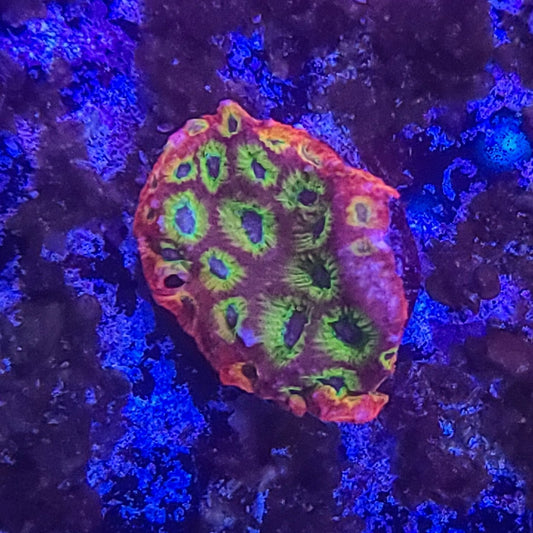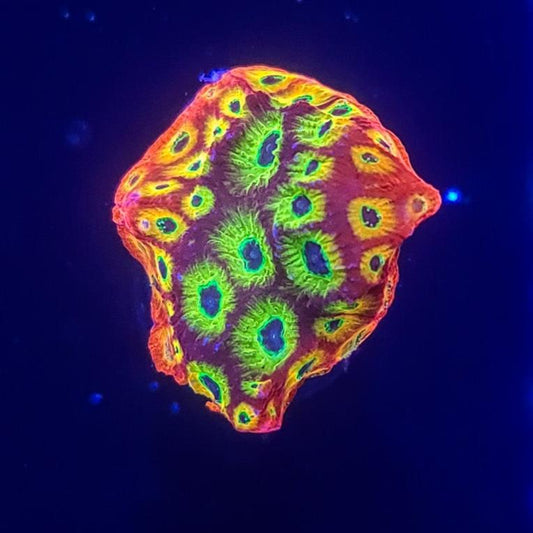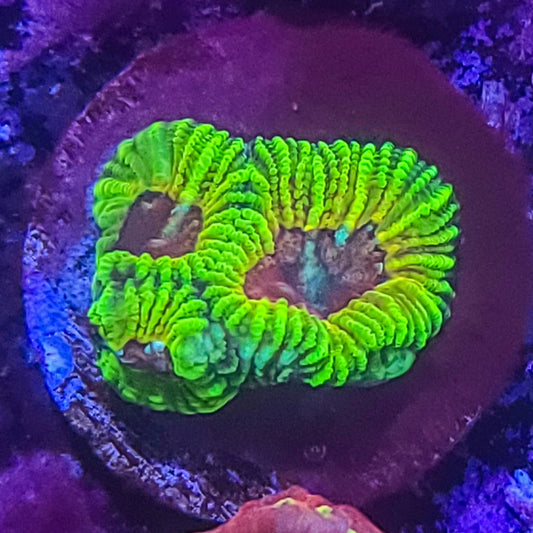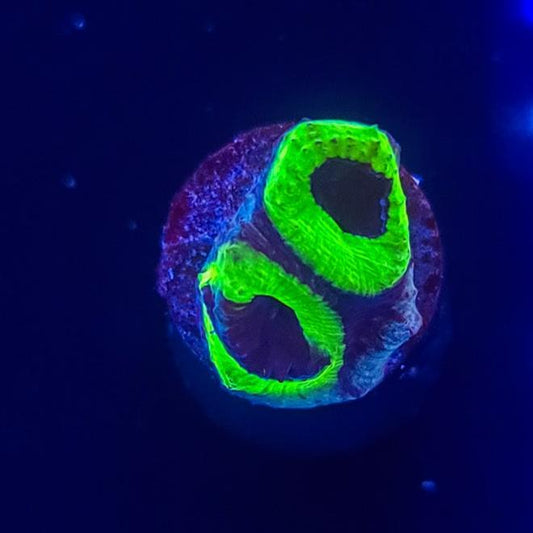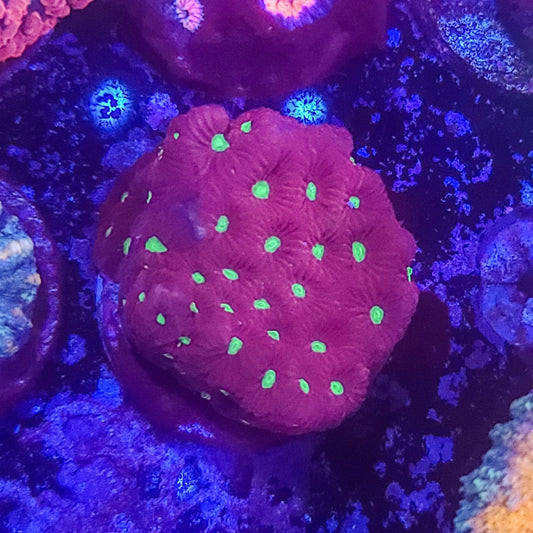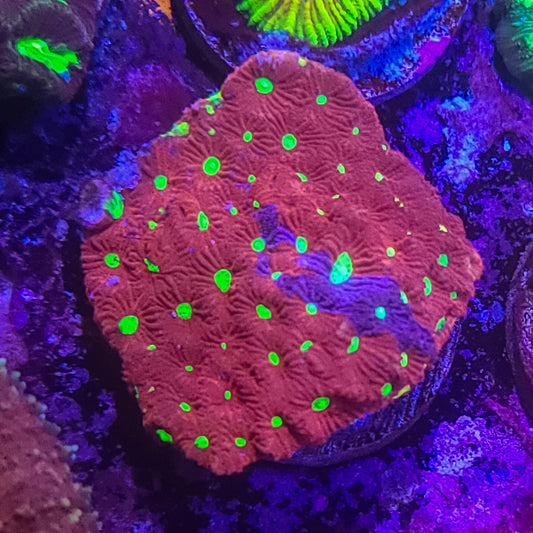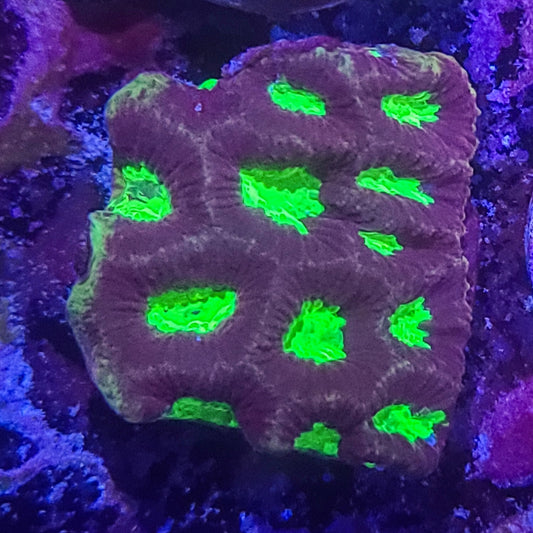Collection: Favia
Favia are large polyp stony (LPS) corals traditionally known as "brain corals" or "closed brain corals," representing one of the most diverse and colorful groups of reef-building corals available to aquarium hobbyists. While the scientific classification has evolved over the years with many former Favia species now reclassified into genera like Dipsastraea, Goniastrea, Coelastrea, and Favites, the term "Favia" remains widely used in the aquarium trade to describe this remarkable collection of dome-shaped, brain-like corals.
These hardy and visually stunning corals are excellent choices for both beginner and experienced reef keepers, offering incredible variety in colors and patterns while remaining relatively forgiving in care requirements. Questions? Contact Sanctuary Aquatics today for Favia coral care info.
-
Favia: Flame Boy Favia 011 3C
Regular price $29.99Regular priceUnit price / per -
Favia: Flame Boy Favia L52
Regular price $23.99Regular priceUnit price / per -
Favia: Mayan Sun 024 6I
Regular price $27.99Regular priceUnit price / per -
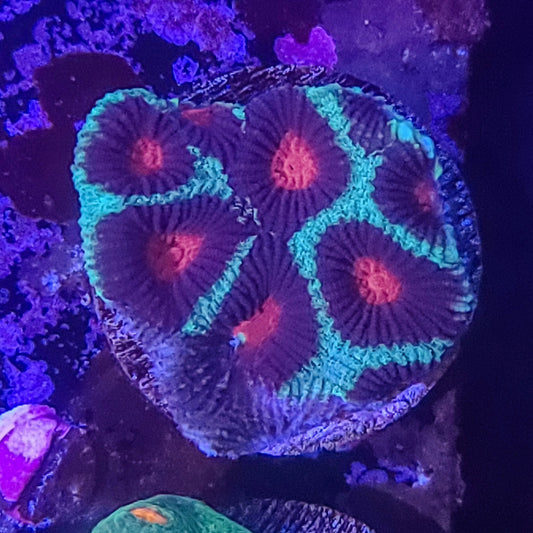 Sold out
Sold outFavia: Prism Favia 024 15E
Regular price $39.99Regular priceUnit price / per -
Favia: Prism Favia L32
Regular price $29.99Regular priceUnit price / per -
Favia: Red War Coral Favia 011 4A
Regular price $29.99Regular priceUnit price / per -
Favia: War Coral Favia 024 7I
Regular price $34.99Regular priceUnit price / per -
Favia: Dragon Soul Favia 024 6J
Regular price $47.99Regular priceUnit price / per
About Favia Coral
Favia corals are characterized by their distinctive dome-shaped or circular colonies with large, fleshy polyps arranged in a brain-like pattern of ridges and valleys. Each polyp maintains its own individual skeletal wall, distinguishing them from their closely related cousins, Favites, which share fused skeletal walls between polyps. This structural difference becomes clearly visible when the polyps retract, making identification possible for experienced hobbyists.
Found throughout the Indo-Pacific region, including Japan, Australia, and parts of Africa, these corals naturally inhabit a wide range of depths and reef environments, from shallow lagoons to deeper reef slopes. This adaptability to various conditions in nature translates to their remarkable tolerance in captive reef systems, contributing to their reputation as hardy aquarium specimens.
The diversity within the Favia group is truly extraordinary, with specimens available in virtually every color and pattern imaginable. From subtle earth tones of brown, green, and yellow to vibrant combinations featuring blues, purples, reds, and oranges, these corals offer endless possibilities for reef aquascaping. Popular varieties include the iconic Dragon Soul with its tri-color pattern and neon green mouths, Reverse Prism featuring striking purple and teal combinations, War Coral displaying deep reds and greens, and countless other named morphs that showcase the incredible genetic diversity within this group.
Favia corals exhibit various growth forms, including massive dome-shaped colonies, submassive formations, and encrusting varieties that spread across rock surfaces. In mature specimens, the intricate skeletal structures create complex three-dimensional landscapes that add tremendous depth and visual interest to reef aquariums. Their growth rate varies significantly among different species, with some varieties like certain Favites growing remarkably fast while others like Coelastrea species grow quite slowly.
One important behavioral characteristic of Favia corals is their ability to extend long sweeper tentacles for defense and feeding. These tentacles can reach several inches beyond the coral's base, requiring careful consideration of placement and spacing to prevent conflicts with neighboring corals.
Caring for Favia Coral
To ensure the best results for your Favia coral, please follow our suggestions on coral care below. It's important to test your tank's water often to ensure the parameters are within the correct range.
Water Parameters
- Temperature: 72-82°F (22-28°C)
- Salinity: 1.023-1.025
- pH: 8.0-8.4
- Alkalinity: 8-12 dKH
- Calcium: 400-450 ppm
- Magnesium: 1250-1350 ppm
- Nitrate: 5-10 ppm (can tolerate slightly elevated levels)
- Phosphate: <0.03 ppm
Lighting
Sanctuary Aquatics suggests low to moderate lighting (50-150 PAR). Lower to middle areas of the tank are best for placement. Favia corals perform best under moderate lighting conditions and can actually suffer under high-intensity illumination. Most varieties thrive in PAR levels between 50-150, with many preferring the lower end of this range.
These corals are not as light-demanding as many other stony corals and will often show their best coloration under moderate conditions. Excessive lighting can lead to bleaching, stress, or color loss, so it's always better to start with lower intensity and gradually increase if needed.
Water Flow
Low to moderate indirect flow that provides gentle water movement around the coral. Excessive flow can damage the fleshy polyps and prevent proper feeding behavior.
The ideal flow should be strong enough to keep the coral clean and deliver nutrients while allowing the polyps to extend fully and capture food particles. Circular flow patterns work particularly well, positioning the coral just inside the flow path to receive gentle lifting currents.
Placement, Temperament, & Notes on Fish
Lower to middle tank placement is ideal for most Favia species. These corals require adequate spacing due to their sweeper tentacles, which can extend several inches from the colony to defend territory and capture food. While generally peaceful toward other coral species, they will sting neighboring corals that encroach on their space.
When placing Favia corals, secure them to stable rockwork using coral-safe glue, allowing them to begin the encrustation process. Once established, they will grow and spread across available surfaces, making long-term placement planning important.
Most reef-safe fish species are compatible with Favia corals, but avoid species known for nipping at coral polyps, such as butterflyfish, some angelfish, and certain wrasses. The large, fleshy polyps can be particularly attractive to fish that browse on coral tissue.
Feeding
While Favia corals derive significant nutrition from their symbiotic zooxanthellae algae through photosynthesis, they greatly benefit from supplemental feeding and will not reach their full growth potential without additional nutrition. These corals are excellent feeders with good prey capture abilities, often accepting food placed directly on their mouths.
Feed 2-4 times per week during evening hours when feeding tentacles are extended. Suitable foods include small meaty items such as mysis shrimp, brine shrimp, finely chopped seafood, zooplankton, small pellets, and specialized LPS coral foods. The food size should be small enough for individual polyps to fully ingest. Turn off water flow for 20-30 minutes during feeding sessions to allow proper food capture and consumption.
Regular feeding not only promotes faster growth but also enhances the vibrant coloration that makes these corals so desirable. Well-fed Favia specimens often display more intense colors and healthier tissue development.
Explore Our Favia Coral Varieties
At Sanctuary Aquatics, we have dozens of Favia coral varieties and various other coral species to choose from. These magnificent corals showcase an incredible spectrum of colors, patterns, and growth forms that will captivate any reef enthusiast. From the legendary Dragon Soul with its mesmerizing tri-color pattern and neon accents to the stunning blue Blue Eyed Favia, our selection includes both classic and rare morphs. Favia corals create stunning focal points that add both color and structural interest to reef aquariums. These corals are particularly rewarding for patient hobbyists, as their true beauty becomes apparent as they mature and develop their characteristic intricate skeletal formations.
At Sanctuary Aquatics, we develop our Favia coral knowledge from marine science research and years of hands-on reef keeping experience. We are dedicated to helping you succeed with your Favia coral care, so contact us or call us at 920-385-4802 and we can provide the help and resources you need to create a successful coral tank!

